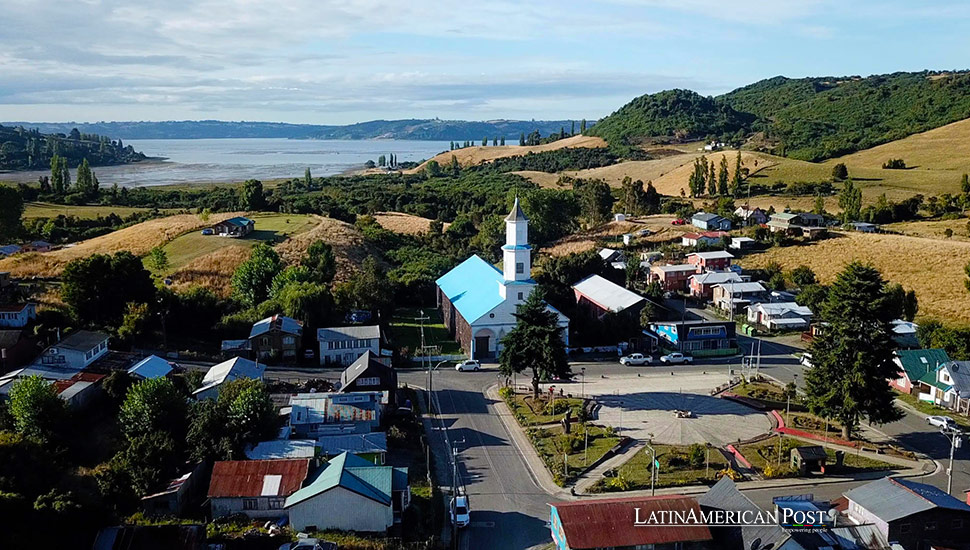Chiloé’s Cultural and Natural Riches Drive Rural Tourism Boom in Chile

Chiloé, a unique archipelago with UNESCO-listed wooden churches, ancestral legends, diverse gastronomy, and over 250 native potato varieties, is positioning itself as Chile’s prime rural tourism destination.
Nestled in the southern reaches of Chile, the Chiloé Archipelago boasts a cultural richness that sets it apart as a prime destination for rural tourism. This archipelago of 40 islands, known for its UNESCO-listed wooden churches, mythical legends, traditional gastronomy, and an impressive variety of native potatoes, offers visitors an authentic glimpse into Chile’s heritage.
For over three decades, Doris Millán, 61, has guided visitors through Chiloé. As one of the first female guides in the region, she plays a vital role in connecting tourists with the indigenous communities that have been historically marginalized. “My job is to bring tourists closer to the indigenous communities. The ancestral culture is the foundation of Chiloé’s culture,” she tells EFE while guiding a group on a mussel-picking adventure in the village of Rilán on the main island.
“Here in Chiloé, no one goes hungry. When the tide goes out, the sea gives us plenty of shellfish, and our forests are full of fruits,” Millán explains. After collecting shellfish, the group heads to ‘Nuevo Amanecer,’ a newly opened rural restaurant where they learn to prepare a traditional “curanto al hoyo” under the guidance of Maribel Méndez.
The current culinary highlight of Chiloé involves placing potatoes, meats, sausages, and shellfish into a pit lined with hot stones and covered with nalca leaves. “I decided to name my restaurant ‘Nuevo Amanecer’ because this is a new beginning for me,” says Méndez, who hopes to leave the strenuous work of fishing behind for a new life in hospitality.
The Ancestral Potatoes of Chiloé
The iconic Toronto wouldn’t be complete without “micro” and “Chapelle,” two doughy creations made from flour and native potatoes, another of the archipelago’s treasures. Chiloé is home to a remarkable diversity of native potatoes, with some estimates suggesting there were once over a thousand varieties before the arrival of the Spanish. Today, around 250 varieties remain.
Yolanda Millapichun, 63, is one of the few “guardians of ancestral seeds” left in Chiloé. In her garden in Puqueldón on Lemuy Island, she cultivates 112 varieties of native potatoes. “It’s hard to say which one I love the most. It’s like asking a mother to choose her favorite child,” Millapichun says as she plans to organize tourist visits to her garden.
Chiloé’s unique potato varieties have earned recognition from the FAO’s Globally Important Agricultural Heritage Systems (GIAHS), an initiative that acknowledges sustainably managed agroecosystems rich in biodiversity and traditional knowledge. “We have types and shades of potatoes that don’t exist anywhere else. What fascinates tourists is the diversity of species, their colors, their spots,” explains Andrea Céspedes, head of tourism for Puqueldón.
Puqueldón gained international attention in 2022 when the United Nations World Tourism Organization (UNWTO) named it one of the “Best Tourism Villages.” This accolade recognizes destinations that use tourism as a catalyst for development. Besides its potato fields, Puqueldón is known for preserving its heritage through its three historic wooden churches: Ichuac, Aldachildo, and Detif. These late 18th-century structures exemplify the fusion of indigenous and European building techniques.
The churches are part of the “Chiloé Churches Route,” a tourist circuit that includes 16 churches that were declared UNESCO World Heritage Sites in 2000. These architectural marvels are spiritual centers and symbols of the region’s rich cultural tapestry.
A Sustainable Future for Chiloé
Aware of the need to maintain its allure while preserving the environment, Puqueldón has recently implemented an innovative recycling program. This initiative involves local artisans who contribute to keeping the islands pristine and sustainable.
“The churches speak for themselves, but we need to spread our culture through our people. I try to reach every corner of the archipelago because that’s where you find the real Chilote,” concludes guide Doris Millán.
Chiloé’s cultural identity is deeply rooted in its history and mythology. The archipelago has long been inhabited by the Huilliche people, a Mapuche subgroup whose legends and traditions continue to influence local life. Spanish colonization in the 16th century brought Catholicism, leading to the construction of the unique wooden churches that blend European and indigenous architectural styles.
Chiloé’s isolation from mainland Chile fostered a distinct culture where community cooperation, known as “minga,” and respect for nature are paramount. This sense of community is evident in the preparation of curanto, a communal meal that brings people together to celebrate their shared heritage.
Promoting Rural Tourism
The push to promote rural tourism in Chiloé aligns with broader trends in Latin America, with growing interest in sustainable and community-based tourism. Countries like Peru, with its Andean communities, and Costa Rica, with its ecotourism initiatives, have successfully leveraged their cultural and natural assets to attract tourists seeking authentic experiences.
Chiloé’s strategy showcases its unique cultural practices, traditional cuisine, and natural beauty. By involving local communities and emphasizing sustainability, Chiloé aims to offer tourists a genuine and respectful glimpse into its way of life.
Rural tourism provides significant economic opportunities for Chiloé’s residents. It diversifies income sources, which is particularly important in a region where fishing and agriculture are predominant. Tourism can also stimulate local businesses, from artisanal crafts to hospitality services, creating jobs and fostering economic resilience.
The involvement of women like Doris Millán and Maribel Méndez highlights the potential for tourism to empower local communities. By taking on roles as guides and entrepreneurs, these women preserve their cultural heritage and inspire others to participate in the tourism sector.
Challenges and Opportunities
While the prospects for rural tourism in Chiloé are promising, challenges remain. Ensuring that tourism development is sustainable and benefits local communities without compromising the environment is crucial. Infrastructure improvements, such as better transportation and accommodation facilities, are necessary to support increased tourist activity.
Additionally, maintaining the authenticity of cultural practices while adapting to tourist expectations requires careful management. It’s essential to balance showcasing traditions and preserving their integrity.
Also read: Santander Reports Unauthorized Data Access in Chile, Spain, and Uruguay
As Chiloé continues to develop its rural tourism offerings, collaboration between local communities, government agencies, and international organizations will be essential. Initiatives like the FAO’s GIAHS and the UNWTO’s Best Tourism Villages provide valuable frameworks for sustainable development.
By embracing its cultural heritage and natural resources, Chiloé can position itself as a leading destination for rural tourism in Latin America. The archipelago’s commitment to sustainability and community involvement ensures that tourism growth will benefit visitors and residents, preserving Chiloé’s unique identity for future generations.




